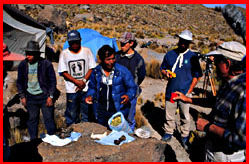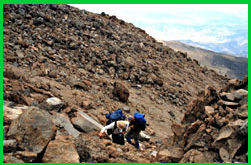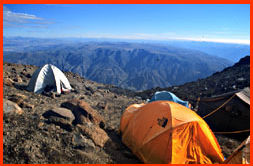 |
 |
 |
 Digging in Thin Air, September 21, 1996
Digging in Thin Air, September 21, 1996Written and Photographed By Liesl Clark The Ascent | Digging in Thin Air | The Mummy's Journey | Preserving the Past An Offering to Sara Sara A thin layer of smoke drifts up toward Sara Sara's summit as Arcadio feeds the burning ashes with more coca leaves. He offers each one of us a handful of leaves to chew on throughout the ceremony. Two llama fetuses lie on the stone-cum-sacrificial-altar at our base camp. Arcadio, who is one of Jose Antonio's Peruvian team members, places burning ashes on a small flat stone, adding incense and coca leaves to it. He holds the stone over his head as if toward Sara Sara, and then in the 4 cardinal directions. He explains, "Making an offering like this to the mountain deities pleases them. This puts the people in harmony with nature and the mountain. The mountains are alive and we must pay respect to them." Each one of us takes part and offers the burning ashes to Sara Sara and the 4 directions as a small cup of wine is passed around. Several of the team members dip their fingers in the wine and sprinkle it on the ground, or "Earth Mother," known as "Pachan Mama." The llama fetuses, which are dried, "represent the essence of the llama," explains Johan. "In Andean cosmology, the mountain deities are perceived to be the owners of the llamas and alpacas. Locals continue to feed these mountains, which are still believed to control the weather and fertility." Before each of his excavations on sacred Andean peaks, Johan performs this ritual offering to appease the mountain deities that have become an integral part of his life and work.  Up to the Summit Camp
Up to the Summit CampThe crunching sound of small rocks (called talus), sand, and boulders under our feet has become all too familiar on the 3,000- foot vertical ascent from base camp to the summit camp near 18,000 feet. On such a steep ascent, with shifting ground beneath our feet, we sink back down several inches with each step up. Thunder clouds roar and groan in the distance and we all hope the weather systems continue to stay at a safe distance to our north. We pick our way over a pile of boulders stacked on a 70- degree slope as James Brundige, mountaineer and sound recordist, jokes, "One of those rocks has your name on it ... it could give way at any moment." No one seems to laugh as we try to scramble over the precarious route. One ill-placed step and it's a long way down.  The high camp looks like an early Inca terraced agricultural system giving
bloom to a crop of tents. The site was chosen because it is out of the wind
and has a good ice and snow supply for our never-ending water needs. It sits,
however, on a slope, so we all have to carve out flat platforms to sleep on.
Several of the team arrive with various ailments picked up along the way:
throat problems, coughs, intestinal problems, bruised ribs, and blisters. But
nothing compares to the affect altitude can have on a person. Just about
everyone has been affected by hypoxia, or lack of oxygen, in one way or
another. Most of us have the attendant headache that accompanies climbing
high, whereas others have experienced nausea, upset stomachs, difficulty
breathing, lack of sleep, and general light headedness. The key to surviving
is to keep hydrated and warm.
The high camp looks like an early Inca terraced agricultural system giving
bloom to a crop of tents. The site was chosen because it is out of the wind
and has a good ice and snow supply for our never-ending water needs. It sits,
however, on a slope, so we all have to carve out flat platforms to sleep on.
Several of the team arrive with various ailments picked up along the way:
throat problems, coughs, intestinal problems, bruised ribs, and blisters. But
nothing compares to the affect altitude can have on a person. Just about
everyone has been affected by hypoxia, or lack of oxygen, in one way or
another. Most of us have the attendant headache that accompanies climbing
high, whereas others have experienced nausea, upset stomachs, difficulty
breathing, lack of sleep, and general light headedness. The key to surviving
is to keep hydrated and warm.Continue Expedition '96 | Dispatches | Mummies | Lost Worlds | Mail Resources | Site Map | Ice Mummies of the Inca Home | BBC Horizon Editor's Picks | Previous Sites | Join Us/E-mail | TV/Web Schedule About NOVA | Teachers | Site Map | Shop | Jobs | Search | To print PBS Online | NOVA Online | WGBH © | Updated November 2000 |